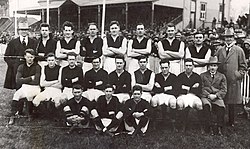28th season of the Victorian Football League (VFL)
The 1924 VFL season was the 28th season of the Victorian Football League (VFL), the highest level senior Australian rules football competition in Victoria. The season featured nine clubs, ran from 26 April until 27 September, and comprised a 16-game home-and-away season followed by a finals series featuring the top four clubs.
The premiership was won by the Essendon Football Club for the sixth time and second time consecutively, after it won the round-robin finals series which was held in this season only. It is the last time a VFL/AFL premiership was not decided by a grand final.
The season saw the first presentation of the Brownlow Medal for fairest and best player in the league, won by Edward Greeves (Geelong).
Background
In 1924, the VFL competition consisted of nine teams of 18 on-the-field players each, with no reserves, although any of the 18 players who had left the playing field for any reason could later resume their place on the field at any time during the match. Each team played each other twice in a home-and-away season of 18 rounds (i.e., 16 matches and 2 byes); once the 18 round home-and-away season had finished, the 1924 VFL premiership was determined by an experimental 1924 finals system, which the VFL used in this season only. The format was similar to the round-robin format used in 1897 Finals System, but included the minor premier's right to challenge, which existed under the amended Argus System.
In 1924, the VFL dispensed with the amended Argus system and adopted a new finals system initially proposed by Carlton delegate Reg Hunt. The new scheme saw the top four clubs play a round-robin semi-finals series over three weeks, with two matches played each Saturday. Then, if the minor premiers did not finish on top of the round-robin ladder, a Grand Final would be played between the minor premiers and round-robin winner. Essendon ultimately finished on top of the finals ladder on the basis of its greater percentage than Richmond; and, as minor premier, Essendon won the premiership without a Grand Final.[1]
The scheme was developed primarily as a result of demand for entry to finals matches in the early 1920s exceeding the capacity of the Melbourne Cricket Ground. It was noted that while an average of 80,000 spectators attended a four-game home-and-away round, the capacity of the Melbourne Cricket Ground was limited to about 55,000; and, as such, under the Argus system, in which only one final was played each day, many spectators were turned away. However, playing two semi-finals on each day would allow more spectators to attend.[2]
The original intent of the system was partially realised, with 65,000 spectators attending the first week of semi-finals, and 60,000 attending the second week; although, only 42,000 attended the third week, when the dead rubber between South Melbourne and Fitzroy was played at the Melbourne Cricket Ground and the premiership-deciding Richmond–Essendon match was played on the smaller South Melbourne Cricket Ground. However, even the weeks with higher spectator numbers did not translate to better financial performance: extra competing teams meant more clubs whose members were entitled free admission and fewer neutral spectators paying at the gate.[3] As a result, the new scheme was abandoned at the end of the year and the amended Argus system resumed from 1925.
Home-and-away season
Round 1
Round 2
Round 3
Round 4
Round 5
Round 6
Round 7
Round 8
Round 9
Round 10
Round 11
Round 12
Round 13
Round 14
Round 15
Round 16
Round 17
Round 18
Ladder
| (P) |
Premiers
|
|
Qualified for finals
|
Rules for classification: 1. premiership points; 2. percentage; 3. points for
Average score: 70.0
Source: AFL Tables
Finals series
Finals week 1
Finals week 2
Finals week 3
Finals ladder
Because Essendon had won the minor premiership and the round-robin competition, it was awarded the premiership without the need for a grand final.
Rules for classification: 1. premiership points; 2. percentage; 3. points for
Source: AFL Tables
Finals team squads
As there was no designated grand final, this also meant that there were no grand final teams in 1924;[4] instead there was an "Essendon finals squad", a "Fitzroy finals squad", a "Richmond finals squad", and a "South Melbourne finals squad". Listed in alphabetical order the four squads were:
- Essendon squad: Fred Baring, Syd Barker, Sr. (captain), Norm Beckton, Clyde Donaldson, Charlie Farrell, Tom Fitzmaurice, Jack Garden, Harry Gregory, Charlie Hardy, Harry Hunter, Tommy Jenkins, Roy Laing, Frank Maher, Charlie May, Justin McCarthy, George Rawle, George Shorten, Greg Stockdale, Jimmy Sullivan, and Rowley Watt.[5]
- Fitzroy squad: Bill Adams, Jim Atkinson (captain), Arthur Batchelor, Les Bryant, Charlie Chapman, Goldie Collins, Tommy Corrigan, Arch Dickens, Steve Donnellan, Ern Elliott, Clive Fergie, Jimmy Freake, Len Gale, Tom Hickey, Horrie Jenkin, Gordon McCracken, Stan Molan, Jack Moriarty, Gordon Rattray, Jim Tarbotton, Len Wigraft, and Fred Williams.[6]
- Richmond squad: Jack Barnett, Ted Bourke, Ralph Empey, Clarrie Hall, Joe Harrison, Doug Hayes, Gordon Hislop, Max Hislop, Jim Karthaus, Bob McCaskill, Norm McIntosh, Angus MacIsaac, Keith Millar, Dan Minogue (captain), Mel Morris, Reuben Reid, George Rudolph, James Smith, Jim Spain, Ernie Taylor, Vic Thorp, and George Valentine.[7]
- South Melbourne squad: Harry Alexander, Bobby Allison, Phil Brooks, Martin Brown, Roy Cazaly (captain), Bill Condon, Fred Fleiter, Arthur Hando, Jacky Harris, Ted Johnson, Tom Joyce, Frank Laird, Harold Mahony, Herb Matthews, Bob McDonald, Charles McDonald, Gil Miller, Charlie Nicholls, Jack O'Connell, Ted O'Meara, Frank Ross, Joe Scanlan, Paddy Scanlan, Mark Tandy, and Les Woodfield.[8]
